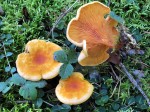 The false chanterelle is found in small clumps in coniferous woodland, especially pines, of Northern temperate zones including North America and Europe. It grows on litter, woodchips, sawdust, and rotten wood from summer into fall. The mushroom stands 1.25 to 3.25 inches high and has a cap .25 to 3.25 inches across. The cap is convex at first, flattens out, and becomes funnel-shaped with age. It is orange yellow and has a felty covering. The thin orange gills are tightly packed, forked, and run down part of the stem. The stem is 1/8 to 3/8 inches across and orange with a brown base. The spores are white.
The false chanterelle is found in small clumps in coniferous woodland, especially pines, of Northern temperate zones including North America and Europe. It grows on litter, woodchips, sawdust, and rotten wood from summer into fall. The mushroom stands 1.25 to 3.25 inches high and has a cap .25 to 3.25 inches across. The cap is convex at first, flattens out, and becomes funnel-shaped with age. It is orange yellow and has a felty covering. The thin orange gills are tightly packed, forked, and run down part of the stem. The stem is 1/8 to 3/8 inches across and orange with a brown base. The spores are white.
There is some controversy over the edibility of the false chanterelle as it may have caused gastrointestinal problems in some people. There is even more controversy about the desirability of eating the mushroom from a culinary stand point as the flesh is rather soft and thin. In addition, it can be confused with poisonous mushrooms such as Jack o’lantern, (Omphalotus olearius). When collecting mushrooms in the wild seek expert advice on identification before eating them.
Photo Credit: By walt sturgeon (Mycowalt) – This image is Image Number 562212 at Mushroom Observer, a source for mycological images.This tag does not indicate the copyright status of the attached work. A normal copyright tag is still required. See Commons:Licensing for more information., CC BY-SA 3.0, https://commons.wikimedia.org/w/index.php?curid=44954592